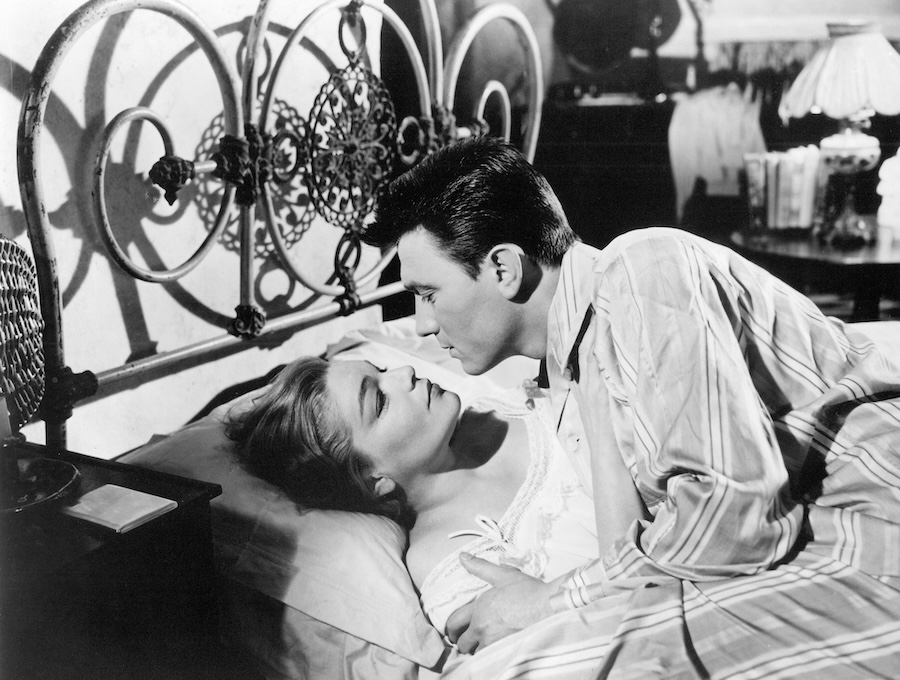
A SAVAGE STORY OF LUST AND AMBITION.

What’s in an ”angry young man”? Is it a person we should fear, someone who doesn’t know how to use his masculinity in a positive way? This is a discussion for our times, it’s not how it was viewed in 1950s Britain. The angry young man became the focus of kitchen sink dramas, a movement that aimed to portray the working class ten years after World War II, a time when young men and women questioned what would become of their lives. The plays, films and novels that emerged mirrored the accents and mores of these people.
In 1959 came the first two film adaptations of kitchen-sink novels: Look Back in Anger and Room at The Top. Especially the latter has become a classic.
Served as a sergeant in the war
In the late 1940s, Joe Lampton (Laurence Harvey) leaves his hometown Dufton for the larger Warnley, a place that might hold a future for him. Having served as a sergeant in the war, and preferring to forget all about it, Joe is ambitious and immediately sets his eyes on Susan Brown (Heather Sears), the daughter of a local industrial tycoon. His job is uninspiring, but Joe dreams of being able to live at the top, which is literally a place in Warnley where the town’s most influential have their homes. While trying his luck as an actor in a hobby production of a play, really an attempt to get close to Susan, Joe gets to know a ten years older French woman, Alice Aisgill (Simone Signoret), who’s unhappily married. Joe ends up balancing two relationships, increasingly unsure of what he’s looking for.
A reputation as difficult
Director Jack Clayton had made an Oscar-winning short, The Bespoke Overcoat (1956), when he was offered this film. Perhaps the immense success of Room at the Top made him uncertain of where to go next. Clayton made a number of films over the following decades, some of them worthy of attention, but he also gained a reputation as difficult, most likely because he was very meticulous about his projects, and because he kept rejecting offers that in hindsight look like unwise decisions. His career also had its moments of sheer bad luck, including a stroke in 1977 that left him unable to work for years.
But in 1959, everything looked very promising. This was his feature debut, and so it was for Laurence Harvey in the lead, who’s very good at illustrating the pent-up anger that’s part of this 25-year-old war veteran. It’s easy to relate to Simone Signoret as Alice whenever she treats him almost like a mother would, as a son who doesn’t know any better because of his lack of experience.
Simone Signoret’s performance becomes an emotional, important part of this competition for Joe.
So, why does she fall in love with him? Because we are complex human beings and there is an obvious attraction between the two. Joe makes Alice feel alive, and she opens his eyes over and over again, even though he’s initially incapable of understanding that he’d be better off committing to her. Signoret’s performance becomes an emotional, important part of this competition for Joe, as he chooses between what’s true and real and what’s the most effective path up to the Top. Romantic and moving, the film is beautifully photographed in West Yorkshire and draws you in, much like a novel.
Remaining more or less close to the original, its bitter ending is worth remembering. The film is also a uncomfortable reminder of women’s situation at the time, including their lack of freedom and financial security. That’s made painfully clear in a scene where Alice’s husband uses the marriage as a weapon to wield against her and anyone who tries to liberate her.
Room at the Top 1959-U.K. 115 min. B/W. Directed by Jack Clayton. Screenplay: Neil Paterson. Novel: John Braine. Cinematography: Freddie Francis. Cast: Simone Signoret (Alice Aisgill), Laurence Harvey (Joe Lampton), Heather Sears (Susan Brown), Donald Wolfit, Donald Houston, Hermione Baddeley.
Trivia: Stewart Granger was considered for the part of Joe; Jean Simmons and Vivien Leigh as Susan. Prunella Scales makes a bit appearance as an office worker. Followed by two sequels, starting with Life at the Top (1965), and a TV series, Man at the Top (1970-1972). Remade as a miniseries, Room at the Top (2012).
Oscars: Best Actress (Signoret), Adapted Screenplay. BAFTA: Best Film, British Film, Foreign Actress (Signoret). Cannes: Best Actress (Signoret).
Last word: “I don’t like doing the same thing twice. Once I’ve done something, I have conquered it and really have no desire to repeat myself. After Room at the Top I was offered every other kitchen sink drama from Saturday Night and Sunday Morning downwards. Once you have created a baby – and it is a baby to me – and it is released into the big wide world, you feel an enormous loss. The last thing you want to do is remind yourself of it, so you set out wanting another one that is quite different.” (Clayton, Starburst Magazine)
